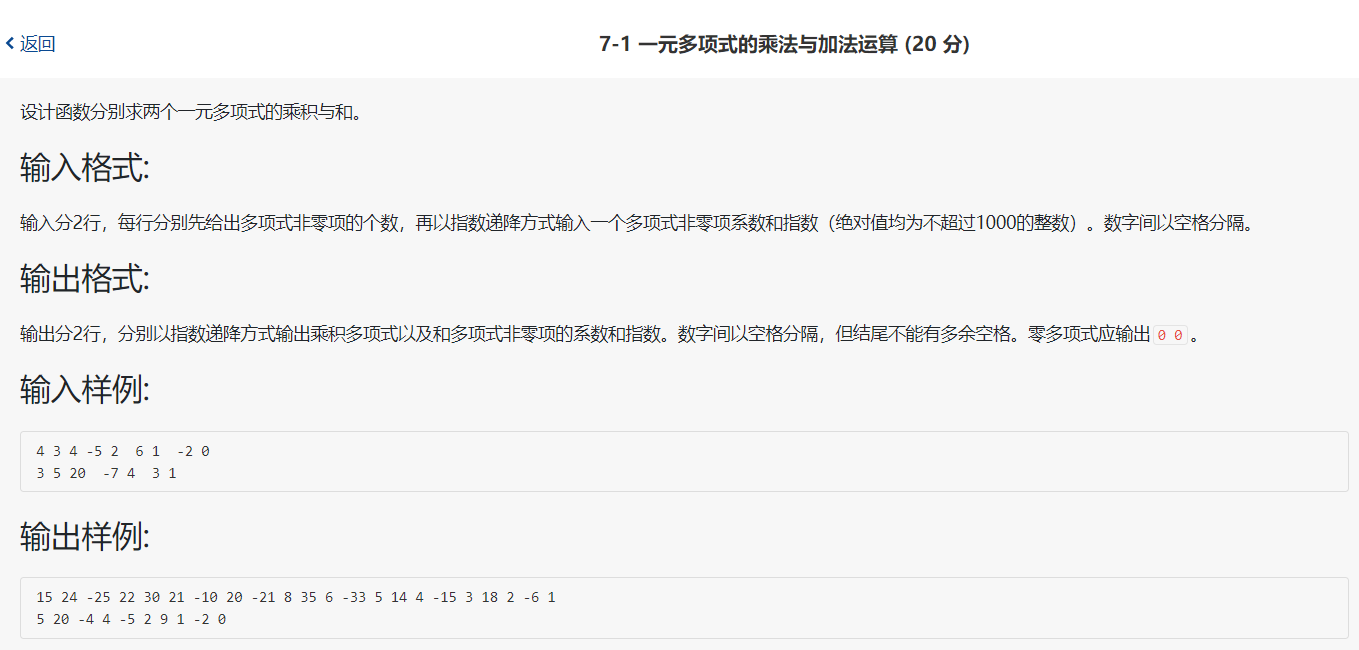
#include<iostream>
#include<cstdio>
#include<cstring>
#include<algorithm>
#include<vector>
using namespace std;
//这里看不明白的话可以看看c语言中typedef的用法:https://blog.csdn.net/theonegis/article/details/40049667
typedef struct PNode
{
int coef; //系数
int expn; //指数
struct PNode *next;
}PNode, *Polynomial;
void Attach(int c, int e, Polynomial *Rear) //将新节点插入到链表的尾部
{
Polynomial P = (Polynomial)malloc(sizeof(PNode));
P->coef = c;
P->expn = e;
P->next = NULL;
(*Rear)->next = P;
*Rear = P;
}
Polynomial Read()
{
Polynomial L = (Polynomial)malloc(sizeof(PNode));
L->next = NULL;
int n;
scanf("%d", &n);
Polynomial rear = L;
while(n--)
{
int a, b;
scanf("%d %d", &a, &b);
Attach(a, b, &rear);
}
Polynomial t = L;
L = L->next;
free(t); //删除临时生成的头节点
return L;
}
Polynomial Add(Polynomial P1, Polynomial P2) //两个多项式的加法
{
Polynomial t1 = P1, t2 = P2;
Polynomial P = (Polynomial)malloc(sizeof(PNode)); //注意malloc出的内存只能用free删除,不能用别的
P->next = NULL;
Polynomial rear = P;
while(t1 && t2)
{
if(t1->expn == t2->expn)
{
int sum = t1->coef + t2->coef;
int expn = t1->expn;
if(sum) //若和不为0,直接将它插入到新链表的末端
Attach(sum, expn, &rear);
t1 = t1->next;
t2 = t2->next;
}
else if(t1->expn < t2->expn) //若指数不相等,则插入指数较大的
{
int coef = t2->coef, expn = t2->expn;
Attach(coef, expn, &rear);
t2 = t2->next;
}
else if(t1->expn > t2->expn)
{
int coef = t1->coef, expn = t1->expn;
Attach(coef, expn, &rear);
t1 = t1->next;
}
}
while(t1) //若有剩余的,依次插入即可
{
Attach(t1->coef, t1->expn, &rear);
t1 = t1->next;
}
while(t2)
{
Attach(t2->coef, t2->expn, &rear);
t2 = t2->next;
}
t2 = P;
P = P->next;
free(t2); //释放头节点
return P;
}
Polynomial Mul(Polynomial p1, Polynomial p2)
{
if(!p1 || !p2) return NULL;
Polynomial t1 = p1, t2 = p2;
Polynomial P = (Polynomial)malloc(sizeof(PNode));
P->next = NULL;
Polynomial rear = P;
while(t2) //先用p1的第一项乘以p2的每一项,得到P
{
Attach(t1->coef * t2->coef, t1->expn + t2->expn, &rear);
t2 = t2->next;
}
t1 = t1->next; //得到p1的下一项,根据前面得到的P,对两个多项式逐项相乘(前面算过的就不用再算了),将它们插入到合适的位置
while(t1)
{
t2 = p2, rear = P; //另一个多项式从初始位置开始
while(t2)
{
int e = t1->expn + t2->expn, c = t1->coef * t2->coef; //两项的*运算
while(rear->next && rear->next->expn > e) //找到下一项的指数小于或等于e的
rear = rear->next;
if(rear->next && rear->next->expn == e) //如果找到指数相同的
{
if(rear->next->coef + c != 0) //系数不为0则加起来
rear->next->coef += c;
else //系数为零了就把这个系数为零的项删除
{
Polynomial t = rear->next;
rear->next = t->next;
free(t);
}
}
else //小于e,则把新项插入到它之后,没理解就慢慢想,画图
{
Polynomial t = (Polynomial)malloc(sizeof(PNode));
t->coef = c;
t->expn = e;
t->next = rear->next;
rear->next = t;
rear = rear->next;
}
t2 = t2->next; //下一项
}
t1 = t1->next; //下一项
}
t2 = P;
P = P->next;
free(t2);
return P;
}
void Print(Polynomial P)
{
int flag = 0;
if(!P)
{
printf("0 0\n");
return ;
}
while(P)
{
if(!flag)
flag = 1;
else
printf(" ");
printf("%d %d", P->coef, P->expn);
P = P->next;
}
printf("\n");
}
int main()
{
// freopen("input.txt", "r", stdin);
// freopen("output.txt", "w", stdout);
Polynomial L1, L2;
L1 = Read();
L2 = Read();
Polynomial sum = Add(L1, L2);
Polynomial mul = Mul(L1, L2);
Print(mul);
Print(sum);
}




